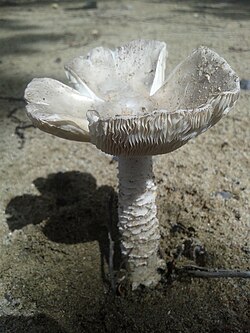Biology:Amanita arenicola
| Amanita arenicola | |
|---|---|

| |
| Scientific classification | |
| Domain: | Eukaryota |
| Kingdom: | Fungi |
| Division: | Basidiomycota |
| Class: | Agaricomycetes |
| Order: | Agaricales |
| Family: | Amanitaceae |
| Genus: | Amanita |
| Species: | A. arenicola
|
| Binomial name | |
| Amanita arenicola Orson K. Miller Jr.
| |
| Amanita arenicola | |
|---|---|
| Mycological characteristics | |
| gills on hymenium | |
| cap is depressed or infundibuliform | |
| hymenium is free | |
| stipe has a volva | |
| ecology is mycorrhizal | |
| edibility: unknown | |
Amanita arenicola, commonly known as the beach-loving ringless amanita, is a species of mushroom-forming fungus in the family Amanitaceae.[2] It is characterized by its gray cap, white stipe with wart-like protrusions, and affinity for sandy shores. Similar to A. vaginata, it lacks a ring on its stem. It can be found on America's Atlantic coastlines.
Taxonomy
Amanita arenicola was first described by mycologists Orson K. Miller Jr. and Jean D. Lodge in 2000, based on a series of specimens found along the coast of Puerto Rico and the Virgin Islands. They were placed in the Amanita sect. Vaginatae due to the absence of a partial veil and the plicate-striate margin present along the cap.[3][circular reference]
The specific epithet arenicola means 'beach' and 'dweller'. A. arenicola is commonly known as the 'beach-loving ringless amanita', due to its distinctive lack of a ring and its presence in coastal areas.
Description
The cap is initially convex, similarly to many other species of Amanita, and grows flatter until it eventually becomes strongly depressed or completely infundibuliform. One source describes fully grown specimens as "moist to sticky, sand covered, smooth, [and] [d]rab [g]ray".[2]
The basidiospores are described as 9-12.5 by 7-10 μm in size and "subglobose to broadly elliptic" in shape[2]
Distribution and habitat
It is distributed along the Atlantic coastlines of the Americas. More recently, specimens have been confirmed throughout Southern Florida and Mexico.[3][circular reference]
As a mycorrhizal species, A. arenicola can usually be found growing around species of Coccoloba uvifera, particularly near the tropics.
Conservation
A. arenicola has been suggested to be an endangered species[1] due to increases in sea level threatening its ecosystem.
See also
References
- ↑ 1.0 1.1 "Amanita arenicola". The Global Fungal Red List Initiative. https://redlist.info/iucn/species_view/467421/.
- ↑ 2.0 2.1 2.2 Miller, Orson K.; Lodge, D. Jean; Baroni, Timothy J. (May 2000). "New and interesting ectomycorrhizal fungi from Puerto Rico, Mona, and Guana Islands". Mycologia 92 (3): 558–570. doi:10.1080/00275514.2000.12061193. https://www.jstor.org/stable/3761516. Retrieved 12 July 2023.
- ↑ 3.0 3.1 "Beach-loving Ringless Amanita (Amanita arenicola)" (in en). https://www.inaturalist.org/taxa/738495-Amanita-arenicola.
Wikidata ☰ {{{from}}} entry
 |


